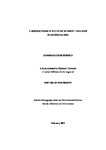A biogeochemical study of nutrient dynamics in artificial soil
| dc.contributor.supervisor | Fitzsimons, Mark F. | |
| dc.contributor.author | Schofield, Hannah Kate | |
| dc.contributor.other | Faculty of Science and Engineering | en_US |
| dc.date.accessioned | 2015-11-06T12:22:01Z | |
| dc.date.available | 2015-11-06T12:22:01Z | |
| dc.date.issued | 2015 | |
| dc.identifier | 10369636 | en_US |
| dc.identifier.uri | http://hdl.handle.net/10026.1/3766 | |
| dc.description.abstract |
Artificial soils have been employed within the Biomes of the Eden Project since its construction in 2000. Produced from sand, bark, composted green waste and lignite clay, these soils were designed to have their nutrient concentrations controlled through careful fertiliser applications. However, following variable environmental conditions, management practices and planting, the soils across the site are performing variably with regard to nutrient retention and storage. Experiments were conducted to assess the performances of an artificial soil in terms of nutrient cycling. This was carried out in three phases: Firstly, soils from the Humid Tropics and Outdoor biomes were sampled and examined, using a range of analytical techniques, to determine the nutrient characteristics of the established artificial soils from across the Eden Project site. This demonstrated that many of the nutrient concentrations of the artificial soils were consistent with those reported for naturally formed soils within comparable environments. All soil samples were of sandy loam texture (ISO 14688-1), with the sand-sized fraction representing > 50 % of the particle size composition. Statistical analyses suggested that management practices had a greater impact on the nutrient characteristics of artificial soils than environmental conditions. Secondly, an artificial soil was produced, following the Eden Project protocol, to examine its performance under controlled environmental conditions. This was packed into 4 columns (1 m height by 110 mm diameter), maintained at 15 ˚C and subjected to an irrigation regime for 52 weeks. Following 26 weeks of irrigation, 2 of the 4 columns were fertilised. Leachate was analysed for dissolved constituents as were solid samples of the fresh soil and of soil samples collected from the columns following 52 weeks irrigation. Leachate concentrations for all nutrients, excepting phosphate, were observed to decline over the irrigation period. Leached phosphate concentrations increased from weeks 0 to 2, and then remained relatively constant. Low nitrogen concentrations within the leachate from weeks 2 to 38 were caused by nitrogen immobilisation within the soil, whilst subsequent mineralisation resulted in increased concentrations from Week 38. Analyses of solid phase constituents determined little variation with depth. Fertiliser application demonstrated a significant (p < 0.05) increase in leachate concentrations for some dissolved organic nitrogen and nitrate, phosphate, magnesium and calcium and a decrease in pH. Fertiliser application observations showed less prominent differences for the extracted and solid phase constituents. Thirdly, biochar was applied to the artificial soil at three concentrations (10 %, 5 % and 2 %) plus a control (0 %), to determine whether biochar application may improve nutrient characteristics of artificial soils. The biochar amended soils were packed into mesocosms and maintained at 15 ˚C for 6 weeks. In general, leachate analyses demonstrated a decrease in nutrient losses to leaching with increasing biochar concentration, highlighting the potential for improved nutrient retention within the soils. | en_US |
| dc.description.sponsorship | European Social Fund, Eden Project, Camborne School of Mines - University of Exeter | en_US |
| dc.language.iso | en | en_US |
| dc.publisher | Plymouth University | en_US |
| dc.subject | Soil | en_US |
| dc.subject | Nutrients | en_US |
| dc.subject | Artificial soil | en_US |
| dc.subject | Biochar | en_US |
| dc.subject | Eden Project | en_US |
| dc.title | A biogeochemical study of nutrient dynamics in artificial soil | en_US |
| dc.type | Thesis | |
| plymouth.version | Full version | en_US |
| dc.identifier.doi | http://dx.doi.org/10.24382/4028 |
Files in this item
This item appears in the following Collection(s)
-
01 Research Theses Main Collection
Research Theses Main


